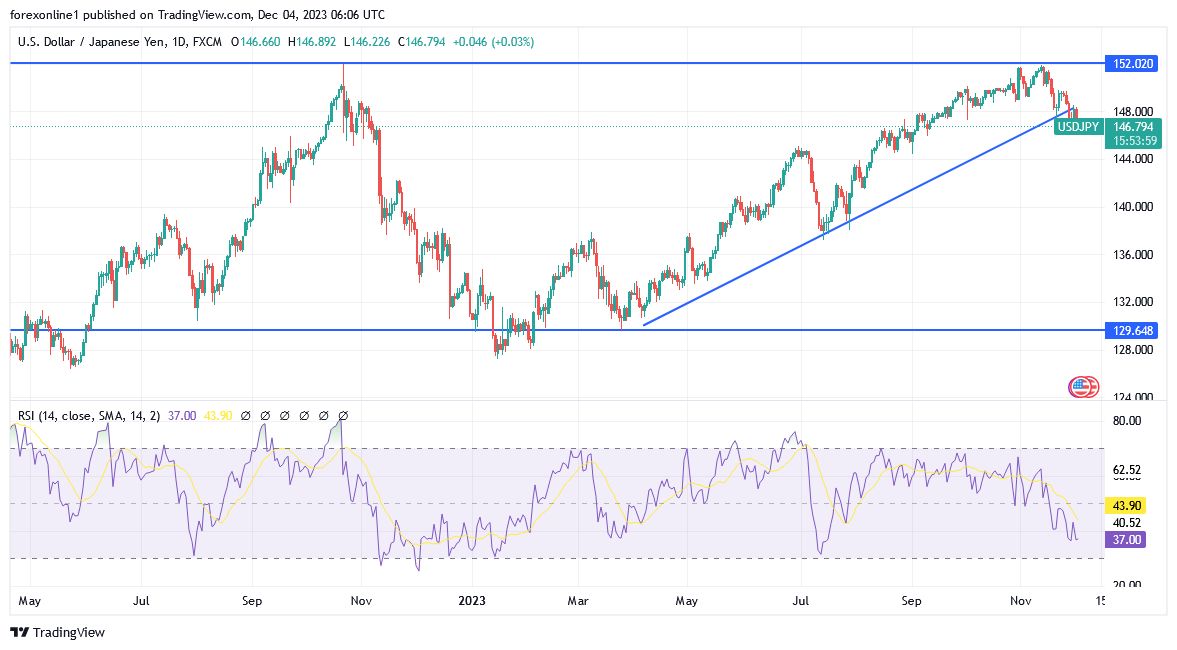- Last week's trading was generally bearish for the performance of the US Dollar against the Japanese Yen (USD/JPY), with losses extending to the support level of 146.66.
- Recently, the week's trading closed near those losses.
- Obviously, the Japanese Yen gained significantly against other major currencies, amid expectations of an imminent shift in the policy of the Bank of Japan.
- Plainly, this conveys the bank of Japan still maintains negative interest rates uniquely compared to other global central banks.
Top Forex Brokers
This week, the return of striking United Auto Workers to U.S. auto assembly lines is expected to lead to an increase in November payrolls, marking a pause in the recent trend of moderating U.S. employment growth. Overall, government data next Friday is expected to show that jobs in the world's largest economy increased by 180,000 after an advance of 150,000 in October. Therefore, such a reading would leave average job growth over the past three months about 100,000 lower than the pace seen earlier in the year.
Meanwhile, the US unemployment rate is expected to remain at 3.9%, the highest level since the beginning of 2022. Also, this is consistent with softer Labor market conditions and more restrained wage growth, helping to calm concerns about inflation and supporting assessments that the Federal Reserve is done raising rates. interest rates. Moreover, the US jobs report is expected to show average hourly wages for November increased by 4% compared to last year, the smallest annual increase since mid-2021.
Recently, the USD/JPY currency pair is trading affected by the results of the latest economic data, as the Jibun Bank of Japan’s manufacturing PMI for November exceeded the expected reading of 48.1 with a reading of 48.3. On Thursday, Japan's unemployment rate for October fell to 2.5% from 2.6% in September, beating the expected rate of 2.6%. The jobs-to-applicants ratio also improved to 1.3 from 1.29 in the previous update, beating expectations of 1.29. In the same week, October retail sales missed expectations of 5.9% with a change of 4.2% annually.
In the United States of America, the personal consumption expenditures and prices index for October came in below the expected change (monthly) by 0.1% with a change of 0%. The (annual) equivalent matches expectations of 3%. On the other hand, the core personal consumption expenditures index for this period was in line with expectations (monthly) and (annual) of 0.2% and 3.5%, respectively. Furthermore, personal spending and personal income matched expectations by 0.2% and 0.2%, while the Chicago PMI beat estimates of 45.4 with a reading of 55.8.
USD/JPY Technical analysis and Expectations Today:
USD/JPY has now advanced to trade above the 100-hour moving average line. As a result, USD/JPY appears to be moving near overbought levels of the RSI on the 14-hour frame. In the near term, and according to the performance on the hourly chart, it appears that the USD/JPY is trading within an ascending channel. This indicates a significant short-term upward bias in market sentiment. Therefore, the bulls - the bulls - will look to extend the current bounce towards 147.20 or higher to 148.00. On the other hand, the bears - the bears - will be looking to pounce on pullbacks at around 146.60 or lower at 145.90.
In the long term, according to the performance on the daily chart, it appears that the USD/JPY currency pair is trading within a descending channel. However, the pair appears to have rebounded recently to avoid falling to the oversold levels of the 14-day RSI. thus, the bulls will look to pounce on extended bounces at around 148.90 or higher at 155.75. On the other hand, the bears - the bears - will be looking to pounce on profits at around 146.69 or lower at the 144.70 support.


